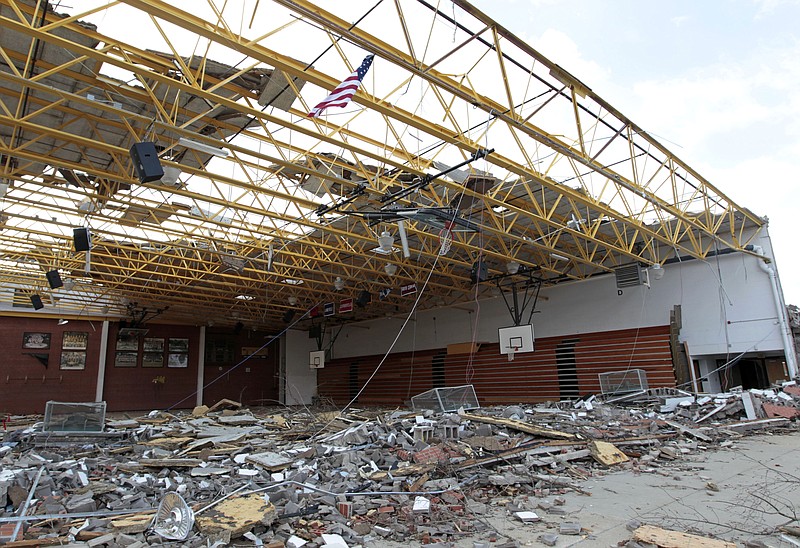By JASON KEYSER and TOM COYNE, Associated Press
HENRYVILLE, Ind. - The tornado came at the worst possible time for the hundreds of students loaded on school buses, ready to head home in Henryville, Ind.
There was no time to follow the preferred safety plan and herd students off the bus and inside the school. Instead, an assistant principal signaled drivers to go, setting off a desperate race to beat the tornado that was just minutes from slamming into the town and destroying a large part of the school.
Unlike snowstorms or hurricanes, which come with plenty of advance warning, tornadoes pose unique challenges for school districts because they can pop up suddenly, leaving little time to scramble to safety. School officials say the choice usually boils down to dismissing class well in advance or sheltering students in the school until the bad weather passes. Neither is guaranteed to save lives.
"When you look at the fact that the average amount of time from a tornado warning being issued to a tornado touching down is five to seven minutes, you can't get them to a safe place in that amount of time," said Bob Roberts, emergency management coordinator for Tulsa Public Schools in Oklahoma.
In Henryville, what seemed like bad timing turned out to be fortunate. Despite harrowing encounters that forced one driver and students to duck into a crawl space and another to seek cover with children on the floor of a car, all the students survived back-to-back tornadoes that devastated the town about 20 miles north of Louisville, Ky.
"The very hallways we would have had those kids in, the ceiling collapsed. Those kids would have been crushed," said John Reed, assistant superintendent of West Clark Community Schools.
But canceling school every time there's a tornado watch isn't practical, since some areas have daily thunderstorms, and many storms never develop actual tornadoes.
"In Kansas in the spring, you would never have school," said Mike Nulton, superintendent of the North Lyon County School District in Kansas, who has been in charge of two schools hit by tornadoes.
School officials' decision can depend in part on the strength of school buildings - some in Oklahoma, for instance, have FEMA-certified safe rooms - and the types of homes in the area. Consideration also goes to whether an adult will be present when a student is dropped off.
Oldham County, Ky., school Superintendent Paul Upchurch said his district has dismissed early once in seven years, and it "was very, very rough." Some children arrived home alone and didn't know what to do as the storm approached. The district now requires parents to pick children up if there's an early dismissal or they'll be sheltered at the school.
School leaders and weather experts say there's no solution that fits every scenario. In Madison County, Ala., school officials prefer to send students home instead of keeping them in school because that reduces the potential for mass fatalities, said Geraldine Tibbs, communications director. But other districts think schools may be the best place to seek shelter.
On Friday, officials at different schools made different decisions. In Piner, Ky., Principal Christi Jefferds pulled her elementary students off buses and had them ride out the storm at the school. Upchurch sent his elementary students home but wished he had held middle and high school students who were on buses when the storm hit.
In Indiana, Reed said officials at West Clark Community Schools, which runs the Henryville schools, held the buses a few minutes after school but decided to let them go when there appeared to be a break in the bad weather.
The drivers hadn't pulled out yet when the tornado sirens sounded.
"I thought, well, I'm gonna floor this baby. I don't care what the law is," said driver Tom Dietrich, 69.
He eventually found himself driving straight toward the tornado and pulled over, running with three remaining students to a house. They made it to the crawl space just as hail started coming down.
On the buses, normally noisy children were quiet. Some told jokes to cover their fear. Smaller children cried, and some put their coats over their heads.
Kayla Lory, 14, said the danger didn't sink in until her bus driver, Fran Munk, asked two older boys to be ready to help evacuate the bus and told students not to walk off the bus, but to run.
"Their eyes were huge," Lory said of the students' reaction. "It just blows my mind how we got home and got safe."
Driver Christina Anderson, 36, said she slowed to a "rolling stop" to let students unload, but no more. With all of them dropped off, she headed home with her three children and her son's girlfriend still on board. They turned a corner and saw an enormous funnel cloud.
"I debated whether to stop and find a ditch to take cover in, but there was just open field," Anderson said. She sped back toward her car, which was parked near the school. They all jumped in the back seat, and Anderson threw herself on top of the children. The funnel cloud lifted one side of the car twice, but they survived.
Munk has no doubt how it happened.
"It's just so evident that God was in control that day," he said. "The sirens were going off. We really should have unloaded the buses and sent the kids back into the school, but we didn't."
---
Coyne reported from South Bend, Ind. Brett Barrouquere in Piner, Ky., Ken Miller in Oklahoma City, Jay Reeves in Birmingham, Ala., Heather Hollingsworth in Kansas City, Mo., and David Pitt in Des Moines, Iowa, contributed to this story.
